LOCAL COMMUNITY EVENT:
Confirmation Day at New Inn Church (Co Galway)
Saturday June 5th 1999
This Internet page contains photographs
which, in certain circumstances, can take a considerable time to download. Some
quotations from the Bible have been included which you may wish to read - in case you are
having to wait.
"Consider the lilies of the field, how
they grow; they neither toil nor spin;
Yet I tell you, even Solomon in all his glory was not arrayed like one of these."
"Look at the birds of the air;
They neither sow nor reap nor gather into barns,
And yet your heavenly Father feeds them."
Ask, and it will be given to you:
Seek, and you will find;
Knock, and it will be opened to you.
For everyone who asks receives,
And he who seeks finds,
And to him who knocks it will be opened.
Thus, when you give alms,
Sound no trumpet before you,
As the hypocrites do
In the synagogues and in the streets,
That they may be praised by men.
But when you give alms,
Do not let your left hand know
What your right hand is doing,
So that your alms may be in secret;
And your Father who sees in secret will reward you.
Judge not, that you be not judged.
For with the judgement you pronounce
You will be judged, and the measure
You give will be the measure you get.
All of the above short extracts were spoken by
Jesus of Nazareth (0000AD to 0033AD) at the Sermon on the Mount.
The Bishop of Clonfert
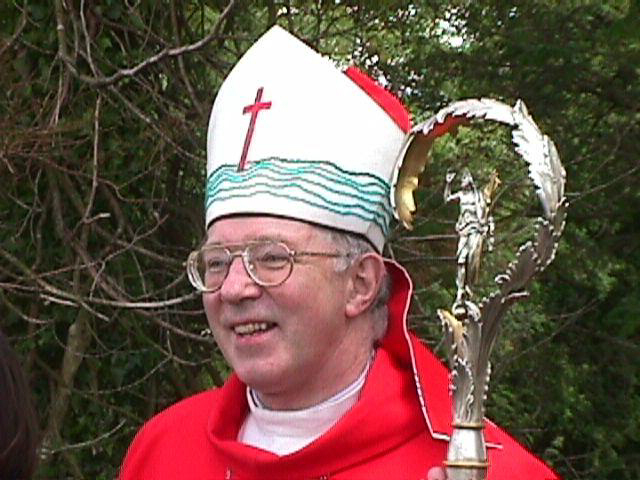
His Lordship the Most Reverend Dr. John Kirby

View of New Inn Church taken during the Confirmation Service
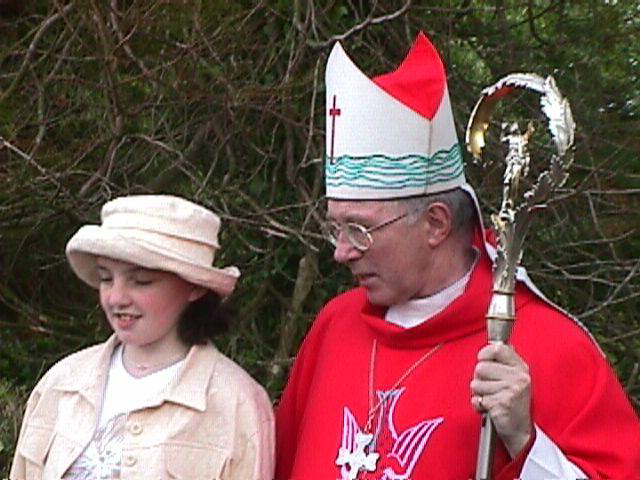
Una Mac Lochlainn

Shane Spellman
THIS AREA IS RESERVED FOR THE PHOTOGRAPHS OF OTHER
PEOPLE WHO MIGHT LIKE TO HAVE THEIR PICTURES OF JUNE 5th PLACED ON THE INTERNET SYSTEM.
Painting of New Inn Primary School
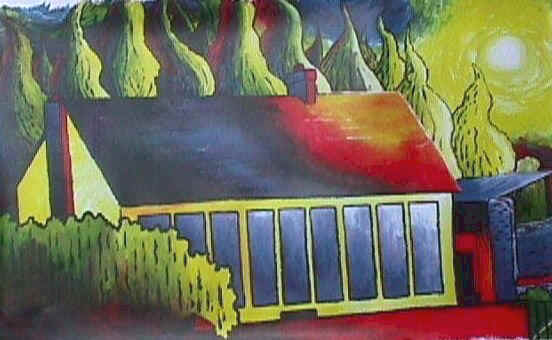
by local artist Eamonn Mac Lochlainn
Detail from wall painting at New Inn Primary
School
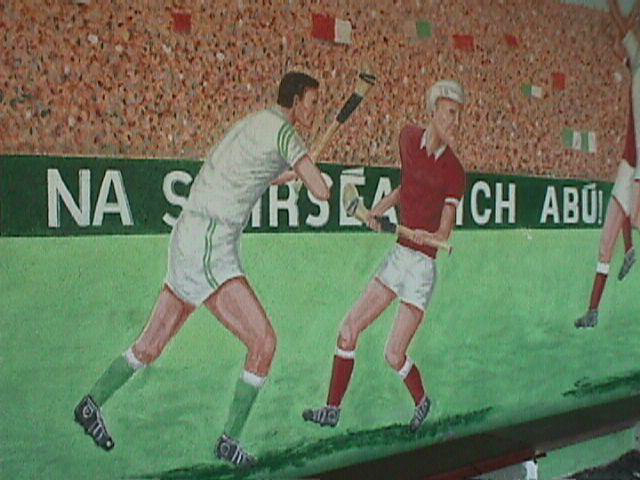
By local artist Gerry Hoban
Several Texaco awards for art have been won by local
artists - and these include Eamonn Mac Lochlainn, and members of Gerry Hoban's
family (please see above).
New Inn village

Entering the village from the Ballinasloe direction (east)
LOCAL HILL-FORTS and the TUROE STONE
If you wish to go directly to the October
7th 1999 update please click: Updates
Just to the left of the road sign in the photograph
above is one of the many, and as yet unexcavated, hill-forts in the New Inn area. Although
it does not appear from the road to be very high, a person standing at the top can get a
surprisingly good view of the surrounding terrain - for a distance of many miles in
most directions.
It is believed that some of these ancient monuments
were built long before Jesus of Nazareth spoke the words quoted at the top of this
page. Several of the local sites, such as Dooley's Fort in Turksland (just a
mile and a half or so to the south east of New Inn), are known to have underground
chambers.
One report Finnerty's have received suggests there
are at least twenty three of these hill-forts still left within a five mile (or so) radius
of New Inn; and it is thought that a few of them are of the "double ring" design
- which some local people seem to think is the sign of a royal fortification. (Note:
It seems likely that several of these so called "hill-forts" are in fact
prehistoric burial mounds. At least one of is known to be a Cairn: which could be anything up to 7,000 years old
- making it much older than the Great Pyramids of Egypt, or the ancient Celtic monument at
Newgrange.)
Some local heritage sites have already been
completely destroyed (or badly damaged), and with the sky-rocketing price of building land
in County Galway, many of them may now face a new and growing threat: that of the
mechanical digger. Galway City, at present one of the most rapidly expanding cities
in Europe, is a just a forty minute drive away from New Inn village.
There is, however, a far greater and more pressing
threat to the whole area at present: in that the County Galway administrators (based in
Galway City, and with amazing powers which appear to ignore all of the normal democratic
principles), decided a year or so ago to earmark a large area of land (at Cross) - which
is right in the middle of this cluster of ancient monuments - as one of three possible
locations for a new super dump designed to take all the rubbish from the whole of County
Galway (or possibly the whole of the Province of Connacht). (Note:
The world famous Turoe Stone - photograph below - is just two miles or so away from
Cross.)
In the hope that it might help to prevent further
irreversible damage to these historic sites, Finnerty's will shortly be sending an Email
to the Connacht Tribune (a popular and influential local weekly newspaper), with
a suggestion that they might wish to consider the contents of this web page - in
connection with the worrying prospect that Cross will eventually be chosen as the site for
the new County Galway Superdump (or possibly the new Province of Connacht Superdump).
What do we know of the people - our local ancestors
- who built this fort? Very little it seems (at present): except that in certain
ways (at least) some of them were extremely sophisticated. Five miles or so to the
south west of New Inn (at Bullaun) this same culture left behind it (above ground) an
elaborately and elegantly carved stone - which is now widely regarded as one of the finest
examples of ancient Celtic art in the world: The Turoe Stone. (The English name
"Turoe" comes from Irish place name "Cloch an Tuair Rua",
meaning "Stone of the Red Pasture".)
Nothing definite seems to be known about the exact
purpose of the Turoe Stone, although for obvious reasons its shape has lead many to
believe it must have been closely connected with fertility rites of some kind. In
recent weeks, we have been informed of some tantalising speculation that the local area
was the power base of prehistoric Queen Meave (who was really a goddess); and that the
magnificently inter-linked carvings on the stone symbolise a centre of power - interwoven
with the energy of the "Rath of Feermhore" site: where the stone originally
stood, and which is a hundred yards or so from its present resting place. Sadly, it
seems the Rath of Feermhore site itself - which some believe may have been closely linked
with Queen Meave's father - was badly damaged and abandoned some years ago (for reasons
that are unclear).
There is additional local speculation that Turoe -
and not the similar sounding word "Temro" (Irish word for Tara) - was
the site of Queen Meave's wedding to a priest-king. History books suggest that up to
the middle of the sixth century "Feis Temro" (which might in reality
have been "Feis Tuair Rua", meaning "The Turoe Festival") was regularly
celebrated in memory of Queen Meave's marriage. In addition, history books suggest that
the royal ancestors of "Niall of the Nine Hostages" (fifth century prince who
took St Patrick to Ireland during one of his many raids on Britain) had their power base
somewhere in the province of Connacht: at Turoe maybe?
Also, the area now known as Woodlawn (three miles
or so to the north of New Inn) is called "Mota Gráinne Oige" in the
Irish language: because, according to traditional belief, Diarmaid and Gráinne (the
subjects of an ancient Irish narrative) stayed there for a short time while they were on
the run from Gráinne's powerful would-be husband: none other than Fionn MacCumhal - who
was head of King Cormac MacArt's elite "Fianna" army. The story of Diarmaid and
Gráinne (in which Diarmaid eventually lost his life), may have been the mother of all
ancient scandals in the Irish region of the Celtic "Empire": which at its peak,
and in its rough and ready way, stretched all the way from the Aran Islands in Galway bay,
right across a wide swathe of central Europe to the Black Sea at least.)
The Turoe Stone

We have evidence of some other important important
matters relating to the Turoe Stone which are set out in the two paragraphs immediately
below:
1) It is similar to the Delphic Omphalos Stone
which marked the center of the ancient Greek world. ("Omphalos"
means navel in Greek: please note the largest circle, towards the top, on the above
photograph.)
2) The ancient Greeks referred in their writings
to a group of rich and powerful tribes which shared a common dress-sense and language
(that was an early relative of the Irish spoken today) - and who sometimes attacked Greek
territory from around 600 B.C. onwards - as "Keltoi", or
Celts. This Celtic culture of the late iron age (of which the Turoe Stone is
believed to be a product) has become known as "La Tène" - after one of their
sites found in Switzerland. Apart from their stone art, these same people also
produced (amongst other things) gold ornaments of amazingly high quality: some of which
have already been found in Ireland. One such item is the beautiful gold collar from
Broighter (in Ulster), which is now in the National Museum of Ireland.
(Interestingly, it appears that the once great Ulster kingdom of Emain Macha was taken
over and destroyed around the time of Niall of the Nine Hostages (or a little
earlier perhaps): by Niall himself and/or his close relatives.)
Might there be other priceless items of stone work
and precious metal objects buried beneath the many hill-forts (and/or burial mounds as the
case may be) in this particular part of East County Galway? Unless (and until) the
remaining sites are subjected to the good quality professional archaeological research
they appear to so much deserve, it seems we may never know; and if things are left too
long, more may be partly or wholly swept away by bulldozers and such like: thereby making
archaeological investigation extremely difficult, or totally impossible perhaps.
We would be interested in hearing from anybody who
can help us to find out more about the culture of the local people who built the hill-fort
in New Inn (photograph below); and who we know produced at least one supreme piece
of stone art just a few miles away at Turoe. (The Turoe Stone is generally believed
to have been carved sometime between 100 B.C to 250 B.C.)
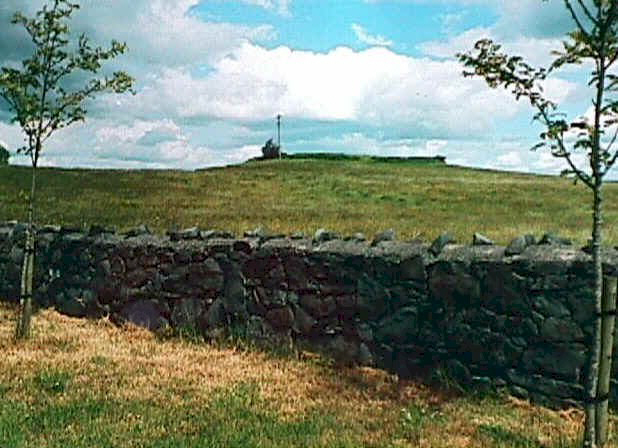
The hill-fort in New Inn village
NOTE: Strange as it may
seem, many tourist guide publications completely ignore East County Galway, and there is
one very prestigious version (1997 "LETS GO: IRELAND) on display at Finnerty's -
compiled by students from Harvard University, and published by Macmillan - which contains
the following sentence: "avoid east Co. Galway: Ballinasloe may excite farmers,
but even the cows wouldn't recommend it." Perhaps we in New Inn and surrounding
areas could do more to make people outside our communities aware of the very rich
abundance of ancient archaeological sites which surround us?
Sometime in the future (if time permits), after we
have added a map and some more photographs of other interesting places in our area - such
as the spectacular ruins of Kilconnel Friary (five miles or so to the east of New Inn, and
founded in 1353 on the site of a much older sixth century monastery), we plan to Email all
of the several major tour guide publishers who at present appear to be completely ignoring
our part of County Galway. We intend to suggest that they might wish to have a look
at certain parts of this web site: with a view to possibly including some mention of our
area in the tourist guides they are now preparing for YEAR 2000, and beyond.
Hopefully, this might lead to extra visits from tourists - and consequently more in the
way of friendships and prosperity for the people of New Inn and surrounding areas.
As we already have the Email address for "LETS
GO: IRELAND" (please see above), we intend to Email the publishers today (July 7th
1999) regarding the contents of this web page. Provided they are willing, and with a
little luck, there might just be enough time for them to include some mention of our area
in their Year 2000 edition of "LETS GO: IRELAND".
Finally, we would like to make it clear that we
have not spent any time trying to find out why local Irish archaeologists appear to have
little or no interest in the cluster of prehistoric hill-forts (and/or burial mounds)
around the New Inn area. However, we suspect it may just simply be that the
necessary funds have not been available to them; and this being the case, the thought has
crossed our minds that wealthy Harvard University (please see above) might have what it
takes to send a talented and well equipped team of researchers to the New Inn area for a
few months: to try to establish, while there is still time, just how much of the
local speculation relating to the ancient Celtic monuments in our area is true? It is
our intention to send an Email to Harvard University regarding these thoughts sometime
before next Saturday (July 10th 1999).
This section added on Saturday July 10th
1999.
The three emails referred to above (to the Connacht
Tribune, the publishers of "LETS GO: IRELAND, and Harvard
University) have now been sent.
Following comments relating to the superdump
issue contained in a front page headline report in the July 9th 1999 edition of the
Connacht Tribune, two further emails have been sent to Heritage Minister Ms Sile de
Valera, and to Minister of State Mr. Éamon Ó Cuív TD.
Basically, these two emails asked the above
mentioned politicians to take account of the contents of the information on this web page
in relation to the superdump issues; and in addition (allowing for the increased Internet
publicity the Turoe Stone is now receiving), that they consider the security and safety
aspects of what is arguably the most important stand-alone piece of pre-Christian Celtic
stone art in existence.
Copies of all five emails mentioned above can be
seen by members of the public at Finnerty's shop in New Inn, County Galway.
OCTOBER 7th 1999 UPDATE
| So far, the five Emails referred to in the
July 10th 1999 section immediately above appear to have failed completely to produce any
useful results that we know of. Regrettably, it looks as though our Emails to the
people concerned are being ignored (for all practical purposes). In the case
of Heritage Minister Ms Sile de Valera, copies of our Emails to her were sent through the
registered post on July 17th 1999; and this was because they kept being returned with
various "non deliverable" Internet messages when we tried to send them to her in
the normal way. (Receipt of our registered letter to Minister Sile de Valera was
acknowledged in a letter dated July 27th 1999 from her office.) However, and despite the above, there have been a number of positive
responses from other people we sought help from, and one of these (which we are using to
represent all) is reproduced below. It came from
Lonely Planet (one of
the world's largest producers of tourist guides, with offices in England, France,
Australia, and the United States of America).
|
Text of Email dated July
20 1999 from Lonely Planet:
Dear Sirs,
Thank you for the information. I
enjoyed reading it, and accessing your genuinely community-motivated Web site. I
will certainly be including this information in the feedback I pass on to the editors of
the next edition (for YEAR 2000). They then pass on the letters to the authors, who
research the new title themselves. This is how we process submissions from the public for
all our titles.
Thanks again for the message, and the
best of luck in your efforts to preserve The Turoe Stone.
Lonely Planet
www.lonelyplanet.com
|
|
NEW LOCAL WEB SITE
You can now find further information relating to the
Turoe Stone at a new local web site (situated in Bullaun).
Clicking on the Internet page address below will
take you directly to the part of the site in question:
Note: There are return links at the
Turoe site back to this one.
|
|

|
![]() Letter to President Mary McAleese (December
29th 2000)
Letter to President Mary McAleese (December
29th 2000) ![]()